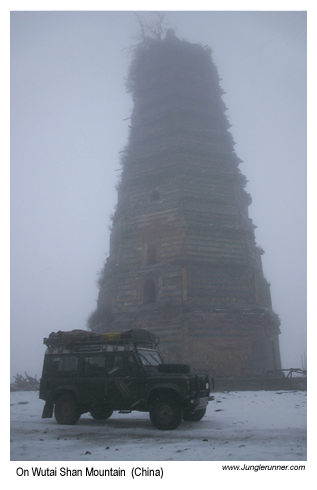
#38 - Shanxi & Shaanxi province (China)
Jeff
Willner - 29 April 2002
(Xi'an,
CHINA) � Leaving Beijing we drove west and then south
through Shanxi province (and then Shaanxi province), spending over
a week visiting Buddhist temples, holy mountains, ancient cities,
and eating ourselves silly. Northern Chinese food features a lot
of wheat so you tend to find noodles and dumplings a lot, though
the big cities would also feature a few southern cuisine restaurants
heavy on the spices and rice. Restaurants are a central part of Chinese
culture, no matter what the income level in a town there are always
rows of restaurants and Allen (our guide) said that it is common
for virtually everyone to eat out at least two or three times a week.
Of all the countries we visited China has the best food! By the second
week in the country I found myself watching the clock in the truck
anxiously waiting for lunch time. "I'm getting a bit peckish,
anyone else hungry?" "Jeff it's ten thirty." I sigh
and keep driving. If ever there was a place to eat four meals a day
(besides the all you can eat 24-hr cruise ship buffet) it's China.
The only tragedy is the lack of good coffee. Tea is fine but nothing
finishes a meal like a hot cup of joe. We resorted to carrying a coffee
press and fresh ground beans. By the end of the week I realized that
I had added a new addiction to my long standing love of coffee - I
just hope there is a good noodle shop back in Toronto when this trip
is over.
Most of the driving was done on new expressways or smoothly paved
two lane national highways. If the government relaxes the requirement
for vehicle-based groups to have their own guide it would be quite
fun to rent a car in Beijing and do the 1000km trip independently (though
the lack of English signs and speakers would be a challenge). Arriving
in Xi'an signalled the end of the touristy part of the trip. We relaxed
in 'civilization' with fast food, easy internet, and a few nights at
a western style hotel complete with English TV channels. To the west
the landscape would be more extreme and the population more sparse.
We would be leaving traditional China with it's Han ethnic majority
and going into the Muslim minority area - less developed, smaller cities
with fewer attractions and more rugged lifestyle. The staging area
for Tibet.
In case you do decide to visit northern China and want to explore
outside the beaten path, here is a list of the places we visited (with
a brief rating):
| Area |
Attraction |
Rating
(out of five) |
| Shanxi Province |
| Datong |
Yungang Shiku (Cloud Ridge Buddhist Caves) |
***** |
| " |
Xuankong Si (Hanging Monastery) |
*** |
| near Hunyuan |
Heng Shan Mountain (cable car to mountain top
and several monasteries) |
* |
| Taihuai |
Wutai Shan Mountains (dozens of monasteries in
valley and on mountain peaks) |
**** |
| near Pingyao |
Qiao Jia Dayuan (Qiao Family Courtyard House, Raise
the Red Lantern filmed here) |
*** |
| Pingyao |
Ancient Ming dynasty walled city, Rishengchang
Financial House Museum |
***** |
| Shaanxi Province |
| Hua Shan |
Holy Buddhist Mountain (2200m-high granite peaks
reached by climbing thousands of steps) |
**** |
| near Xi'an |
Terracotta Warriors (2000-year-old army of thousands
of lifesize ceramic warriors in battle formation) |
***** |
| Xi'an |
Bell Tower, City Walls, Great Mosque (also features
McDonalds, great shopping and fast internet) |
**** |
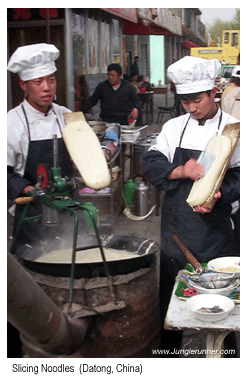 Our
fist stop after Beijing was Datong to see the Buddhist caves.
We stayed at a hotel that defines the word 'rathole'. Aside from
the standard filthy carpet it boasted fungus coated shower pipes,
intermittent spitting hot water trickle, and the ever popular
pervasive open sewer scent. Sally, Kathryn and I decided to try
our luck at a local restaurant without Allan. Bad idea. Not only
did we not get any discount but our food turned out to be not
really quite what we thought we were ordering. Long strips of
fuzzy intestines floating in a spicy sauce - ummm maybe not. Our
fist stop after Beijing was Datong to see the Buddhist caves.
We stayed at a hotel that defines the word 'rathole'. Aside from
the standard filthy carpet it boasted fungus coated shower pipes,
intermittent spitting hot water trickle, and the ever popular
pervasive open sewer scent. Sally, Kathryn and I decided to try
our luck at a local restaurant without Allan. Bad idea. Not only
did we not get any discount but our food turned out to be not
really quite what we thought we were ordering. Long strips of
fuzzy intestines floating in a spicy sauce - ummm maybe not.
The next morning on the way to the Buddhist caves with
low morale and lower expectations we drove past this sidewalk
kitchen that seemed to be catering to truckers. Allen jumped
out and promptly started ordering. Two cooks were hand slicing
noodles into a pot of boiling water, another deep frying
donuts in a vat of oil, and several others sold an assortment
of odd breakfast foods (dirt covered eggs, rice gruel). Some
of the more adventurous dishes were too much for our westernized
stomachs but the noodles were great - and so were the donuts.
The best part was watching these two chefs slicing noodles
rapid fire.
|
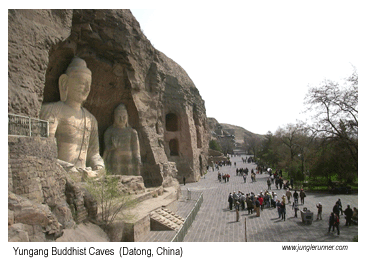 |
"Buddhist caves" read
the guidebook, what is a buddhist cave and how could it be worth
the hours of driving I wondered. Arriving at Yungang we visited
the first couple of caves with carved walls and small statues,
gradually the statues got bigger, and bigger, till walking along
the sidewalk these gigantic carved Buddhas burst into sight.
It was overwhelming, completely unexpected, and very very impressive.
Outside we spent over an hour buying old calligraphy, ceramics,
brass figures and paintings from the street vendors. Allan had
to almost drag us back into the truck to stay on schedule. |
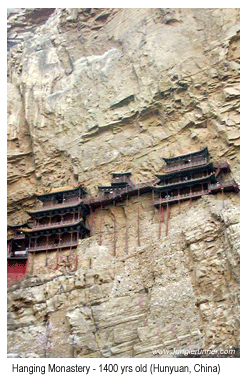 Down
the road from Yungang is the famous hanging monastery of Hunyuan.
This architectural marvel is perched on the edge of a steep cliff
face and was built over 1400 years ago. Really the picture says
it all. It's a monastery. It's built on a cliff-edge. We walked
through it to be sure, and yes, it is indeed a cliff-edge monastery.
I might be a bit bitter about this place because the parking
attendant stole about $20 off me in a confusion of spilled money,
high wind, and quick fingers. Down
the road from Yungang is the famous hanging monastery of Hunyuan.
This architectural marvel is perched on the edge of a steep cliff
face and was built over 1400 years ago. Really the picture says
it all. It's a monastery. It's built on a cliff-edge. We walked
through it to be sure, and yes, it is indeed a cliff-edge monastery.
I might be a bit bitter about this place because the parking
attendant stole about $20 off me in a confusion of spilled money,
high wind, and quick fingers.
The Chinese government has decided that by 2008 it will
be the top tourist destination in the world, and they are
investing substantial sums of money into roads, public facilities,
and changes to the regulations to achieve this goal. For
example, it used to be that foreigners could only stay in
one or two 'tourist' hotels - these days in China you can
stay in any hotel in town which means competition is up and
prices are down. Even so, getting used to the western sensibilities
is taking some getting used to. Bathrooms are a prime example.
Most Chinese have grown up with outhouses in the back and
a bucket bath once a week. That is normal. So virtually all
hoteliers invest anywhere but the bathrooms. The feeling
is that if there is a hole and a bucket of water that's all
you need. You have to go to a new three star hotel before
toilet seats appear and the odour goes away. |
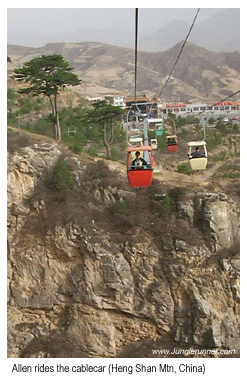 Heng
Shan mountain was another example of the authorities not quite
'getting it'. We were charged an entrance fee to drive up the
road to this picturesque peak - one of China's holy Buddhist
mountains. Once we arrived at the parking lot we had to pay a
parking fee. At the top there was literally nothing to do but
climb thousands of feet - or take a cable car. So feeling a bit
ripped off after much grousing we ponied up for a one-way ride
thinking we could enjoy the scenery and walk down. Arriving at
the top station we were told the only way we could continue on
the path was to pay an extortionate monastery entrance fee. 'We
didn't want to see any monasteries.' Too bad, the path goes through
there, you must pay! 'Forget it we will go back down.' Fine
but since you didn't buy a round-trip ticket you must pay a premium
fee to return on the cable car. Heng
Shan mountain was another example of the authorities not quite
'getting it'. We were charged an entrance fee to drive up the
road to this picturesque peak - one of China's holy Buddhist
mountains. Once we arrived at the parking lot we had to pay a
parking fee. At the top there was literally nothing to do but
climb thousands of feet - or take a cable car. So feeling a bit
ripped off after much grousing we ponied up for a one-way ride
thinking we could enjoy the scenery and walk down. Arriving at
the top station we were told the only way we could continue on
the path was to pay an extortionate monastery entrance fee. 'We
didn't want to see any monasteries.' Too bad, the path goes through
there, you must pay! 'Forget it we will go back down.' Fine
but since you didn't buy a round-trip ticket you must pay a premium
fee to return on the cable car.
That was the last straw. Fortunately Allen was on our side
and after haranguing the ticket clerk for fifteen minutes
we were allowed to bush barge down the side of the mountain
bypassing the monastery back to the main path down. On the
way down Allen had to listen to three MBAs tell him in no
uncertain terms why the menu pricing system was flawed, what
defined deceptive advertising, and how truly pissed off we
were with the whole experience. He survived and we went off
and found a hotel that did two things the Chinese do very
very well - great food and cheap sauna (with massage).
|
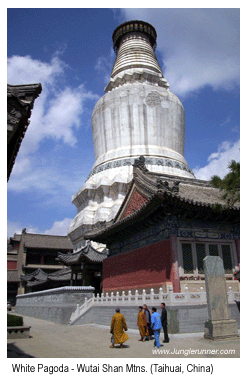 Wutai
Shan is a group of five mountain peaks that surround the little
village of Taihuai. Another of the holy Buddhist mountains, the
place was undergoing a dramatic revitalisation. Domestic tourism
is huge in China, a growing middle-class pile into the family
car and drive down one of the new highways to experience a bit
of the country with the kids. It reminded me of cramming into
the family station wagon with my six siblings when Dad took us
across the US to see Disneyland. Taihuai's hundreds of Buddhist
temples offer an even more compelling lure to the locals (despite
the lack of roller coaster rides) and each May the city is flooded
with thousands of nationals. Wutai
Shan is a group of five mountain peaks that surround the little
village of Taihuai. Another of the holy Buddhist mountains, the
place was undergoing a dramatic revitalisation. Domestic tourism
is huge in China, a growing middle-class pile into the family
car and drive down one of the new highways to experience a bit
of the country with the kids. It reminded me of cramming into
the family station wagon with my six siblings when Dad took us
across the US to see Disneyland. Taihuai's hundreds of Buddhist
temples offer an even more compelling lure to the locals (despite
the lack of roller coaster rides) and each May the city is flooded
with thousands of nationals.
We were fortunate to visit just before the onset of the
tourist stampede and were able to drive the Land Rover up
the muddy track to the very top of the mountains, where several
of the most sacred monasteries were wreathed in blowing snow.
'You receive extra blessing for coming all this way', we
were assured by the monks in their spartan, freezing chapels.
They must have been right because that night we found a genuine
Brunswick bowling alley in town complete with tacky rental
shoes. After three frames we were all feeling the touch of
home. It was a nice mix of the new and old, the sacred and
mundane, though I suspect that a Space Mountain ride isn't
too far in the future for this booming little alpine village.
|
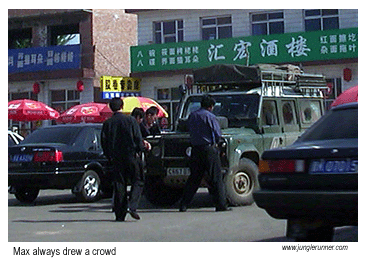 |
No matter where we went, the Land
Rover always attracted a crowd. It is big, bad, and clearly capable
of tackling the roughest terrain - and the van drivers loved
to crowd around it nodding and (every time) kicking the tires.
Jody purchased a plastic world map much earlier in the trip and
we put it in the rear side window with a black marker line to
show where we have visited. The map bridged the language barrier
quite effectively. Point. They make a circle motion as if to
say, 'You have been around the entire world??' Nod vigorously.
The whole crowd goes wild. And for an encore I always washed
my hands in the rear faucet under the back bumper - knocks 'em
dead every time. |
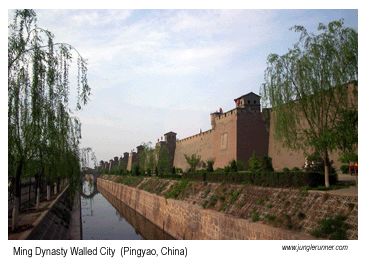 |
At the end of our first week we stayed
in the ancient walled city of Pingyao. Formerly the center of
Chinese banking, progress and foreign competition crushed almost
all the local banks and for almost a century it languished. Industry
and progress passed the city by leaving the town remarkably preserved.
These days the city is benefiting from the decades of isolation.
Tourists take bicycle rickshaws around the top of the intact
Ming dynasty wall, or wander the maze of shops. One of our most
enjoyable nights of the week was spent wandering the red lantern-lit
streets, browsing the old shops and sampling the food in Pingyao's
old city. |
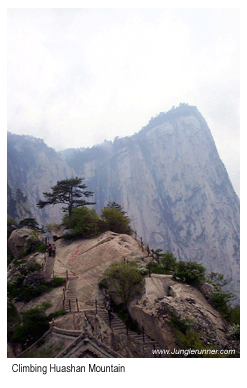 "Come
on Jeff, let's climb the mountain!" But...why? After two
somewhat traumatic experiences on Kilimanjaro I subscribe far
less to the whole "because it is there" school of thought.
There was a very nice Austrian-built cable car to the lower summit
that would allow us to wander comfortably between the peaks.
But no. Kathryn and Sally needed to 'do' the mountain. In their
defence, the guide-book describes a 'tough climb to the top that
rewards you with stunning views and weary limbs'. It doesn't
really get specific about the thousands and thousands and thousands
of steps cut into the granite cliffs that are so steep at times
one must cling to a metal chain. All in all we climbed 2200m
vertically over a distance of 15km. Seven hours of solid climbing
later as we neared the exit with aching legs, Kathryn making
sideways loops because the path sloped too steeply and Sally
nursing an injured knee, I asked if we had 'done' the mountain
enough. They weren't impressed. "Come
on Jeff, let's climb the mountain!" But...why? After two
somewhat traumatic experiences on Kilimanjaro I subscribe far
less to the whole "because it is there" school of thought.
There was a very nice Austrian-built cable car to the lower summit
that would allow us to wander comfortably between the peaks.
But no. Kathryn and Sally needed to 'do' the mountain. In their
defence, the guide-book describes a 'tough climb to the top that
rewards you with stunning views and weary limbs'. It doesn't
really get specific about the thousands and thousands and thousands
of steps cut into the granite cliffs that are so steep at times
one must cling to a metal chain. All in all we climbed 2200m
vertically over a distance of 15km. Seven hours of solid climbing
later as we neared the exit with aching legs, Kathryn making
sideways loops because the path sloped too steeply and Sally
nursing an injured knee, I asked if we had 'done' the mountain
enough. They weren't impressed.
As with most things that cost you a great deal of money
or effort, you ascribe extra value to the experience - and
Huashan is no exception. The cliffs are indeed spectacular
but for the love of mercy if you visit take the cable-car.
|
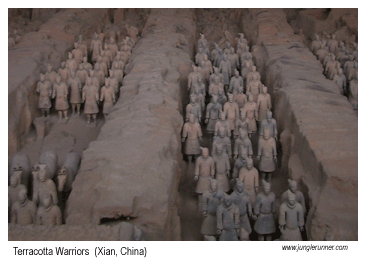 |
In 1974 peasants digging a well uncovered
what is probably the major archeological discovery of the 20th
century - an underground vault of earth and timber that yielded
thousands of life-size terracotta soldiers and their horses in
battle formation. Constructed as part of the royal tomb of Qin
Shihuang (who united China in 221BC, standardised currency and
written script, and was considered the first real emperor) -
each warrior has different features, is clothed in detailed uniform,
and positioned in strict accordance with the book of war. Located
near Xi'an, most tourists visit the site on a day trip from the
city. |
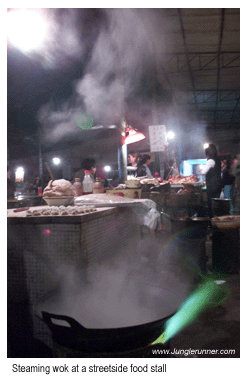 Our
mid-China tour finished in Xi'an which once vied with Rome and
Constantinople for title of greatest city in the world. In antiquity
it was the capitol of China and terminus of the Silk Route. Even
today Xi'an retains an exotic flavour in its alleys and courtyards
not often found in the rest of China. We visited some sights
but mostly just took it easy, staying at a western style hotel
and filling up on fast food. Bargains were easy to find in the
alley markets overflowing with souvenirs, so of course we bought
way too much. It was a good end to the middle part of our tour. Our
mid-China tour finished in Xi'an which once vied with Rome and
Constantinople for title of greatest city in the world. In antiquity
it was the capitol of China and terminus of the Silk Route. Even
today Xi'an retains an exotic flavour in its alleys and courtyards
not often found in the rest of China. We visited some sights
but mostly just took it easy, staying at a western style hotel
and filling up on fast food. Bargains were easy to find in the
alley markets overflowing with souvenirs, so of course we bought
way too much. It was a good end to the middle part of our tour.
For most of the week we definitely had the feeling that
we were special. Tourism hasn't penetrated very far outside
of the major attractions and quite often in smaller villages
fascinated crowds would gather to watch us eat noodles or
pump diesel. We were likely some of the first white people
they had ever seen. It's a rare feeling that we all enjoyed,
the sense of being some of the first outside eyes to see
the sights. Previous visitors to China described it as a
'struggle just to survive' but with the new emphasis on tourism
we had a much easier time (despite the bathrooms). So there
is a unique chance available right now to benefit from the
new ease of travel as the government flings the doors open
to visitors, and beat the coming hordes of foreign devils. |
|


 Our
fist stop after Beijing was Datong to see the Buddhist caves.
We stayed at a hotel that defines the word 'rathole'. Aside from
the standard filthy carpet it boasted fungus coated shower pipes,
intermittent spitting hot water trickle, and the ever popular
pervasive open sewer scent. Sally, Kathryn and I decided to try
our luck at a local restaurant without Allan. Bad idea. Not only
did we not get any discount but our food turned out to be not
really quite what we thought we were ordering. Long strips of
fuzzy intestines floating in a spicy sauce - ummm maybe not.
Our
fist stop after Beijing was Datong to see the Buddhist caves.
We stayed at a hotel that defines the word 'rathole'. Aside from
the standard filthy carpet it boasted fungus coated shower pipes,
intermittent spitting hot water trickle, and the ever popular
pervasive open sewer scent. Sally, Kathryn and I decided to try
our luck at a local restaurant without Allan. Bad idea. Not only
did we not get any discount but our food turned out to be not
really quite what we thought we were ordering. Long strips of
fuzzy intestines floating in a spicy sauce - ummm maybe not.

 Down
the road from Yungang is the famous hanging monastery of Hunyuan.
This architectural marvel is perched on the edge of a steep cliff
face and was built over 1400 years ago. Really the picture says
it all. It's a monastery. It's built on a cliff-edge. We walked
through it to be sure, and yes, it is indeed a cliff-edge monastery.
I might be a bit bitter about this place because the parking
attendant stole about $20 off me in a confusion of spilled money,
high wind, and quick fingers.
Down
the road from Yungang is the famous hanging monastery of Hunyuan.
This architectural marvel is perched on the edge of a steep cliff
face and was built over 1400 years ago. Really the picture says
it all. It's a monastery. It's built on a cliff-edge. We walked
through it to be sure, and yes, it is indeed a cliff-edge monastery.
I might be a bit bitter about this place because the parking
attendant stole about $20 off me in a confusion of spilled money,
high wind, and quick fingers.
 Heng
Shan mountain was another example of the authorities not quite
'getting it'. We were charged an entrance fee to drive up the
road to this picturesque peak - one of China's holy Buddhist
mountains. Once we arrived at the parking lot we had to pay a
parking fee. At the top there was literally nothing to do but
climb thousands of feet - or take a cable car. So feeling a bit
ripped off after much grousing we ponied up for a one-way ride
thinking we could enjoy the scenery and walk down. Arriving at
the top station we were told the only way we could continue on
the path was to pay an extortionate monastery entrance fee. 'We
didn't want to see any monasteries.' Too bad, the path goes through
there, you must pay! 'Forget it we will go back down.' Fine
but since you didn't buy a round-trip ticket you must pay a premium
fee to return on the cable car.
Heng
Shan mountain was another example of the authorities not quite
'getting it'. We were charged an entrance fee to drive up the
road to this picturesque peak - one of China's holy Buddhist
mountains. Once we arrived at the parking lot we had to pay a
parking fee. At the top there was literally nothing to do but
climb thousands of feet - or take a cable car. So feeling a bit
ripped off after much grousing we ponied up for a one-way ride
thinking we could enjoy the scenery and walk down. Arriving at
the top station we were told the only way we could continue on
the path was to pay an extortionate monastery entrance fee. 'We
didn't want to see any monasteries.' Too bad, the path goes through
there, you must pay! 'Forget it we will go back down.' Fine
but since you didn't buy a round-trip ticket you must pay a premium
fee to return on the cable car.
 Wutai
Shan is a group of five mountain peaks that surround the little
village of Taihuai. Another of the holy Buddhist mountains, the
place was undergoing a dramatic revitalisation. Domestic tourism
is huge in China, a growing middle-class pile into the family
car and drive down one of the new highways to experience a bit
of the country with the kids. It reminded me of cramming into
the family station wagon with my six siblings when Dad took us
across the US to see Disneyland. Taihuai's hundreds of Buddhist
temples offer an even more compelling lure to the locals (despite
the lack of roller coaster rides) and each May the city is flooded
with thousands of nationals.
Wutai
Shan is a group of five mountain peaks that surround the little
village of Taihuai. Another of the holy Buddhist mountains, the
place was undergoing a dramatic revitalisation. Domestic tourism
is huge in China, a growing middle-class pile into the family
car and drive down one of the new highways to experience a bit
of the country with the kids. It reminded me of cramming into
the family station wagon with my six siblings when Dad took us
across the US to see Disneyland. Taihuai's hundreds of Buddhist
temples offer an even more compelling lure to the locals (despite
the lack of roller coaster rides) and each May the city is flooded
with thousands of nationals.


 "Come
on Jeff, let's climb the mountain!" But...why? After two
somewhat traumatic experiences on Kilimanjaro I subscribe far
less to the whole "because it is there" school of thought.
There was a very nice Austrian-built cable car to the lower summit
that would allow us to wander comfortably between the peaks.
But no. Kathryn and Sally needed to 'do' the mountain. In their
defence, the guide-book describes a 'tough climb to the top that
rewards you with stunning views and weary limbs'. It doesn't
really get specific about the thousands and thousands and thousands
of steps cut into the granite cliffs that are so steep at times
one must cling to a metal chain. All in all we climbed 2200m
vertically over a distance of 15km. Seven hours of solid climbing
later as we neared the exit with aching legs, Kathryn making
sideways loops because the path sloped too steeply and Sally
nursing an injured knee, I asked if we had 'done' the mountain
enough. They weren't impressed.
"Come
on Jeff, let's climb the mountain!" But...why? After two
somewhat traumatic experiences on Kilimanjaro I subscribe far
less to the whole "because it is there" school of thought.
There was a very nice Austrian-built cable car to the lower summit
that would allow us to wander comfortably between the peaks.
But no. Kathryn and Sally needed to 'do' the mountain. In their
defence, the guide-book describes a 'tough climb to the top that
rewards you with stunning views and weary limbs'. It doesn't
really get specific about the thousands and thousands and thousands
of steps cut into the granite cliffs that are so steep at times
one must cling to a metal chain. All in all we climbed 2200m
vertically over a distance of 15km. Seven hours of solid climbing
later as we neared the exit with aching legs, Kathryn making
sideways loops because the path sloped too steeply and Sally
nursing an injured knee, I asked if we had 'done' the mountain
enough. They weren't impressed.

 Our
mid-China tour finished in Xi'an which once vied with Rome and
Constantinople for title of greatest city in the world. In antiquity
it was the capitol of China and terminus of the Silk Route. Even
today Xi'an retains an exotic flavour in its alleys and courtyards
not often found in the rest of China. We visited some sights
but mostly just took it easy, staying at a western style hotel
and filling up on fast food. Bargains were easy to find in the
alley markets overflowing with souvenirs, so of course we bought
way too much. It was a good end to the middle part of our tour.
Our
mid-China tour finished in Xi'an which once vied with Rome and
Constantinople for title of greatest city in the world. In antiquity
it was the capitol of China and terminus of the Silk Route. Even
today Xi'an retains an exotic flavour in its alleys and courtyards
not often found in the rest of China. We visited some sights
but mostly just took it easy, staying at a western style hotel
and filling up on fast food. Bargains were easy to find in the
alley markets overflowing with souvenirs, so of course we bought
way too much. It was a good end to the middle part of our tour.